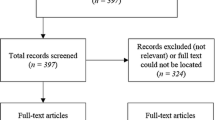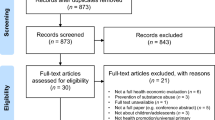Abstract
Suicide is one of the leading causes of death among young people globally. In light of emerging evidence supporting the effectiveness of school-based suicide prevention programmes, an analysis of cost-effectiveness is required. We aimed to conduct a full cost-effectiveness analysis (CEA) of the large pan-European school-based RCT, Saving and Empowering Young Lives in Europe (SEYLE). The health outcomes of interest were suicide attempt and severe suicidal ideation with suicide plans. Adopting a payer’s perspective, three suicide prevention interventions were modelled with a Control over a 12-month time period. Incremental cost-effectiveness ratios (ICERs) indicate that the Youth Aware of Mental Health (YAM) programme has the lowest incremental cost per 1% point reduction in incident for both outcomes and per quality adjusted life year (QALY) gained versus the Control. The ICERs reported for YAM were €34.83 and €45.42 per 1% point reduction in incident suicide attempt and incident severe suicidal ideation, respectively, and a cost per QALY gained of €47,017 for suicide attempt and €48,216 for severe suicidal ideation. Cost-effectiveness acceptability curves were used to examine uncertainty in the QALY analysis, where cost-effectiveness probabilities were calculated using net monetary benefit analysis incorporating a two-stage bootstrapping technique. For suicide attempt, the probability that YAM was cost-effective at a willingness to pay of €47,000 was 39%. For severe suicidal ideation, the probability that YAM was cost-effective at a willingness to pay of €48,000 was 43%. This CEA supports YAM as the most cost-effective of the SEYLE interventions in preventing both a suicide attempt and severe suicidal ideation.
Trial registration number DRKS00000214.


Similar content being viewed by others
References
World Health Organization (2014) Preventing suicide: a global imperative. WHO, Geneva
World Health Organization (2013) Mental health action plan 2013–2020. WHO, Geneva
World Health Organization (2015) Suicide prevention (Supre). http://www.who.int/mental_health/prevention/suicide/suicideprevent/en. Accessed 20 Feb 2017
Aseltine RH, James A, Schilling EA, Glanovsky J (2007) Evaluating the SOS suicide prevention program: a replication and extension. BMC Public Health 7(1):161
Garraza LG, Walrath C, Goldston DB, Reid H, McKeon R (2015) Effect of the Garrett Lee Smith memorial suicide prevention program on suicide attempts among youths. JAMA Psychiatry 72(11):1143–1149
Wilcox HC, Kellam SG, Brown CH, Poduska JM, Ialongo NS, Wang W, Anthony JC (2008) The impact of two universal randomized first-and second-grade classroom interventions on young adult suicide ideation and attempts. Drug Alcohol Depend 95:S60–S73
Wasserman D, Hoven CW, Wasserman C, Wall M, Eisenberg R, Hadlaczky G, Kelleher I, Sarchiapone M, Apter A, Balazs J (2015) School-based suicide prevention programmes: the SEYLE cluster-randomised, controlled trial. Lancet 385(9977):1536–1544
Romeo R, Byford S, Knapp M (2005) Annotation: economic evaluations of child and adolescent mental health interventions: a systematic review. J Child Psychol Psychiatry 46(9):919–930
Centers for Disease Control and Prevention (CDC) (2010) Data & statistics (WISQARS™): cost of injury reports. http://www.cdc.gov/ViolencePrevention/suicide/consequences.html. Accessed 20 Feb 2017
Wasserman D, Carli V, Wasserman C, Apter A, Balazs J, Bobes J, Bracale R, Brunner R, Bursztein-Lipsicas C, Corcoran P (2010) Saving and empowering young lives in Europe (SEYLE): a randomized controlled trial. BMC Public Health 10(1):192
Wasserman D, Carli V, Hoven CW, Sarchiapone M, Wasserman C (2015) Methodology of the SEYLE trial on suicide prevention in schools-Authors’ reply. Lancet 386(9996):854
Wasserman C, Hoven CW, Wasserman D, Carli V, Sarchiapone M, Al-Halabí S, Apter A, Balazs J, Bobes J, Cosman D (2012) Suicide prevention for youth-a mental health awareness program: lessons learned from the Saving and Empowering Young Lives in Europe (SEYLE) intervention study. BMC Public Health 12(1):776
Kaess M, Brunner R, Parzer P, Carli V, Apter A, Balazs JA, Bobes J, Coman HG, Cosman D, Cotter P (2014) Risk-behaviour screening for identifying adolescents with mental health problems in Europe. Eur Child Adolesc Psychiatry 23(7):611–620
Health Service Executive (HSE) Ireland (2010) January 2010 consolidated payscales. HSE. https://www.hse.ie/eng/staff/benefitsservices/pay/payscalesjan2010.pdf. Accessed 20 Feb 2017
KPMG (2010) KPMG’s individual income tax and social security rate survey 2010. KPMG International. https://www.taxation.co.uk/files/IndividualIncomeTax2010.pdf. Accessed 20 Feb 2017
Health Information and Quality Authority (HIQA) (2014) Guidelines for the economic evaluation of health technologies in Ireland. HIQA, Dublin. https://www.hiqa.ie/system/files/Economic-Evaluation-Guidelines-2014.pdf. Accessed 20 Feb 2017
Paykel E, Myers J, Lindenthal J, Tanner J (1974) Suicidal feelings in the general population: a prevalence study. Br J Psychiatry 124(582):460–469
SDQ (2012) Strengths and Difficulties Questionnaire. http://www.sdqinfo.com/a0.html. Accessed 20 Feb 2017
Furber G, Segal L, Leach M, Cocks J (2014) Mapping scores from the Strengths and Difficulties Questionnaire (SDQ) to preference-based utility values. Qual Life Res 23(2):403–411
CHU 9D (2014) The Child Health Utility 9D. https://www.shef.ac.uk/scharr/sections/heds/mvh/paediatric. Accessed 20 Feb 2017
Boyer NRS, Miller S, Connolly P, McIntosh E (2016) Paving the way for the use of the SDQ in economic evaluations of school-based population health interventions: an empirical analysis of the external validity of SDQ mapping algorithms to the CHU9D in an educational setting. Qual Life Res 25(4):913–923. https://doi.org/10.1007/s11136-015-1218-x
Husereau D, Drummond M, Petrou S, Carswell C, Moher D, Greenberg D, Augustovski F, Briggs AH, Mauskopf J, Loder E (2013) Consolidated health economic evaluation reporting standards (CHEERS)—explanation and elaboration: a report of the ISPOR health economic evaluation publication guidelines good reporting practices task force. Value Health 16(2):231–250
Gomes M, Ng ES-W, Grieve R, Nixon R, Carpenter J, Thompson SG (2012) Developing appropriate methods for cost-effectiveness analysis of cluster randomized trials. Med Decis Mak 32(2):350–361
Ng E, Grieve R, Carpenter J (2013) Two-stage non-parametric bootstrap sampling with shrinkage correction for clustered data. Stata J 13(1):141–164
Ng ES, Diaz-Ordaz K, Grieve R, Nixon RM, Thompson SG, Carpenter JR (2016) Multilevel models for cost-effectiveness analyses that use cluster randomised trial data: an approach to model choice. Stat Methods Med Res 25(5):2036–2052
Briggs A, Schulpher M, Claxton K (2006) Decision modelling for health economic evaluation. Oxford University Press, Oxford
Gray AM, Clarke PM, Wolstenholme JL, Wordsworth S (2011) Applied methods of cost-effectiveness analysis in healthcare. Oxford University Press, Oxford
Owens D, Horrocks J, House A (2002) Fatal and non-fatal repetition of self-harm. Br J Psychiatry 181(3):193–199
Funding
The SEYLE project was supported through Coordination Theme 1 (Health) of the European Union Seventh Framework Programme (FP7). Grant agreement number HEALTH-F2-2009-223091. The funder of the study had no role in study design, data collection, data analysis, data interpretation, or writing of the report. The corresponding author (SA) had full access to all the data in the study and had final responsibility for the decision to submit for publication.
Author information
Authors and Affiliations
Corresponding author
Ethics declarations
Conflict of interest
On behalf of all authors, the corresponding author states that there is no conflict of interest.
Ethics approval
The SEYLE study was approved ethically by the European Commission as a precondition of funding approval for the project. Ethical permission for the project, including permission to follow-up individual pupils was obtained in each participating country by the Research Ethics Committees. All requirements of obtaining Informed Consent from pupils and parents were followed carefully.
Electronic supplementary material
Below is the link to the electronic supplementary material.
Rights and permissions
About this article
Cite this article
Ahern, S., Burke, LA., McElroy, B. et al. A cost-effectiveness analysis of school-based suicide prevention programmes. Eur Child Adolesc Psychiatry 27, 1295–1304 (2018). https://doi.org/10.1007/s00787-018-1120-5
Received:
Accepted:
Published:
Issue Date:
DOI: https://doi.org/10.1007/s00787-018-1120-5




